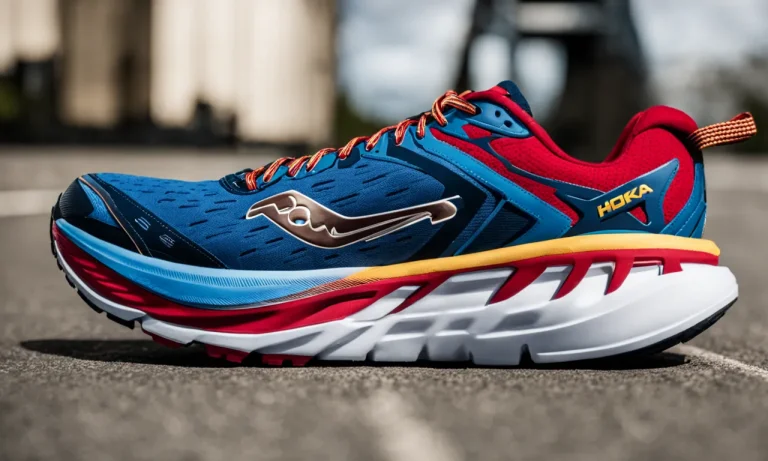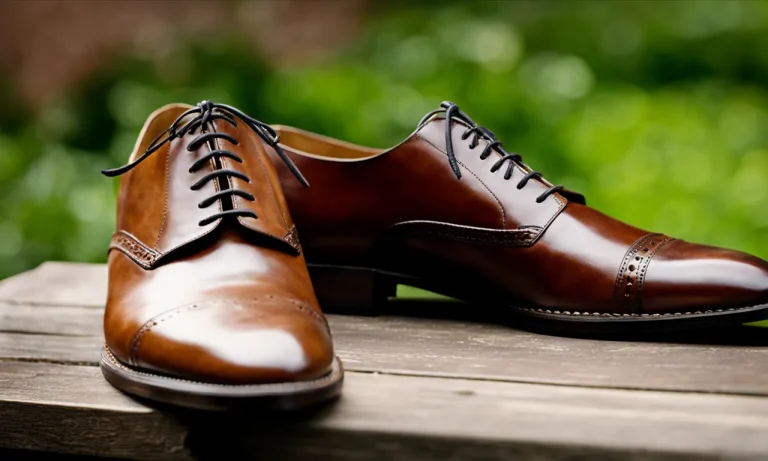Getting caught in the rain while wearing leather boots can be a stressful situation. Will your beautiful leather boots get ruined? What’s the best way to care for wet leather? This comprehensive guide will provide you with tips, tricks, and advice to keep your leather boots looking great, even after getting soaked in the rain.
If you’re short on time, here’s a quick answer: Use a protective spray before going out in wet weather. When you get home, gently wipe boots dry with a clean cloth, stuff with paper to maintain shape, and allow to air dry away from heat. Condition once fully dried.
How Rain Can Damage Leather Boots
While leather boots are often associated with durability and ruggedness, they are not impervious to the damaging effects of rain. In fact, exposure to rain can have several negative impacts on leather boots, compromising their quality and longevity.
Leather Loses oils and Dries Out
One of the main ways rain can damage leather boots is by causing them to lose their natural oils and become dry. Leather is a natural material that requires proper moisture levels to maintain its flexibility and strength.
When exposed to rain, the water can seep into the leather, washing away the oils that keep it supple. As a result, the leather may become stiff, brittle, and prone to cracking.
It’s important to note that not all types of leather are equally susceptible to this issue. Full-grain leather, for example, is generally more resilient and better able to withstand moisture compared to other types of leather.
However, even with high-quality leather, prolonged exposure to rain can still lead to drying out over time.
Leather Can Crack
Another consequence of rain on leather boots is the increased risk of cracking. When leather dries out due to rain or other factors, it becomes more susceptible to developing cracks and fissures. These cracks not only compromise the appearance of the boots but can also weaken the leather’s structure, making it more prone to tearing and damage.
To prevent cracking, it’s crucial to take proactive measures to protect your leather boots from rain. Applying a high-quality leather conditioner or waterproofing product can help replenish the lost oils and create a protective barrier against moisture.
Regularly treating your boots can help maintain their suppleness and reduce the risk of cracks.
Leather Can Become Misshapen
Rain can also cause leather boots to become misshapen. Leather has a natural ability to stretch and mold to the shape of the wearer’s foot over time. However, excessive exposure to rain can disrupt this process and lead to the leather losing its shape.
When leather boots get soaked, they can stretch out or become misshapen as they dry. This can result in uncomfortable fits, blisters, or even long-term damage to the boots. To prevent this, it’s important to allow your leather boots to dry naturally and avoid using artificial heat sources, as they can further distort the leather.
Treating Leather Boots Before Going Out in The Rain
When it comes to wearing leather boots in the rain, it is crucial to take the necessary steps to protect them from water damage. Below are some effective ways to treat your leather boots before braving the rainy weather:
Use a Protective Spray or Cream
One of the best ways to shield your leather boots from rain is by using a protective spray or cream. These products create a barrier on the surface of the leather, preventing water from seeping in and causing damage.
Look for sprays or creams specifically designed for leather footwear, as they are formulated to provide optimal protection. Apply the spray or cream evenly over the entire surface of the boots, paying special attention to seams and stitching.
Allow the product to dry completely before wearing the boots in wet conditions.
Consider Waterproofing Products
In addition to protective sprays and creams, there are also various waterproofing products available for leather boots. These products work by enhancing the natural water-resistant properties of leather.
Some waterproofing products come in the form of wax or oil-based formulas, while others may be silicone-based. Before applying any waterproofing product, it is essential to read and follow the manufacturer’s instructions carefully.
Keep in mind that certain types of leather may require specific waterproofing treatments, so it is always a good idea to consult with a professional or refer to the manufacturer’s recommendations.
It is important to note that while protective sprays, creams, and waterproofing products can significantly reduce the chances of water damage, they do not make leather boots completely waterproof. Extreme exposure to rain or prolonged immersion in water can still cause damage to the leather.
Therefore, it is advisable to avoid wearing leather boots in heavy downpours or submerging them in water for extended periods.
For more information on protecting and caring for leather boots, you can visit www.leathercareusa.com, a trusted website that provides valuable insights and tips on leather care.
Caring for Leather Boots After Getting Wet
Leather boots are a timeless and stylish footwear choice, but they require proper care, especially when they get wet. Whether you’ve been caught in a sudden downpour or accidentally stepped into a puddle, it’s important to take the necessary steps to prevent damage and extend the lifespan of your beloved boots.
Here are some tips for caring for your leather boots after they have gotten wet:
Gently Blot Boots Dry
As soon as you notice that your leather boots have gotten wet, the first step is to gently blot them dry using a clean, absorbent cloth or towel. Avoid rubbing the boots vigorously as this can cause unnecessary friction and potentially damage the leather.
Instead, gently press the cloth against the wet areas to absorb as much moisture as possible. This will help prevent water stains and reduce the drying time.
Stuff Boots With Paper
After blotting the boots dry, the next step is to stuff them with newspaper or plain white paper. This helps to maintain the shape of the boots and facilitate the drying process. Crumple the paper and fill the boots, ensuring that every part is adequately filled.
The paper will absorb the remaining moisture and prevent the leather from becoming misshapen or wrinkled as it dries. Leave the paper in the boots until they are fully dry.
Allow Boots to Air Dry
Once you have blotted and stuffed your boots, it’s essential to allow them to air dry naturally. Avoid using direct heat sources such as hairdryers or heaters, as excessive heat can cause the leather to crack or shrink. Instead, place the boots in a well-ventilated area away from direct sunlight.
This will allow the air to circulate around the boots and facilitate the drying process. Depending on the extent of the wetness, it may take several hours or even a day for your boots to dry completely. Patience is key!
Remember, proper care and maintenance are crucial for the longevity of your leather boots. Once your boots are dry, it’s a good idea to apply a leather conditioner or waterproofing spray to protect them from future moisture damage.
By following these simple steps, you can ensure that your leather boots remain in great condition, even after encountering a rainy day.
Conditioning and Polishing Leather Boots Post-Rain
After getting caught in a rainstorm, it’s essential to take proper care of your leather boots to ensure their longevity and maintain their appearance. Here are some steps to follow when conditioning and polishing your boots after they have been exposed to rain.
Condition Once Fully Dry
The first step in caring for your leather boots after they have been soaked in the rain is to allow them to fully dry. It is crucial not to rush this process by using direct heat sources like a hairdryer or placing them near a radiator.
Instead, place your boots at room temperature and allow them to air dry naturally. This will prevent any potential damage caused by excessive heat.
Use Leather Conditioner or Oil
Once your boots are completely dry, it’s time to condition them. Leather conditioner or oil helps to restore moisture to the leather, preventing it from becoming brittle and cracking. Begin by applying a small amount of conditioner or oil to a soft cloth and gently rub it into the leather in circular motions.
Be sure to cover the entire surface of the boots, including the seams and creases. Allow the conditioner to penetrate the leather for a few minutes before wiping off any excess with a clean cloth. This step will not only nourish the leather but also restore its natural shine.
Buff Away Scuffs or Spots
After conditioning, it’s time to address any scuffs or spots that may have occurred during the rain. To remove scuffs, gently rub a soft cloth or a specialized leather cleaner over the affected area. For stubborn spots, you can use a leather cleaner and a soft-bristled brush to gently scrub the surface.
Be careful not to apply too much pressure, as this can further damage the leather. Once you have successfully removed the scuffs or spots, use a clean cloth to buff the boots, bringing back their original luster.
Remember, regular conditioning and polishing are essential to keep your leather boots looking their best and protecting them from the elements. By following these simple steps, you can ensure that your boots remain in top condition for years to come.
When to Seek Professional Help for Leather Boots
Severe Water Damage
Leather boots are known for their durability and water resistance, but sometimes they can still suffer from severe water damage. If your boots have been exposed to excessive amounts of water or have been soaked for a prolonged period of time, it is important to seek professional help.
Water damage can cause the leather to become weak and prone to cracking. Professional boot repair shops have the expertise and tools to properly dry and restore your boots, preventing further damage and extending their lifespan.
Significant Discoloration or Staining
Over time, leather boots can develop discoloration or staining due to various factors such as exposure to sunlight, dirt, or chemicals. While minor discoloration can often be treated at home with leather cleaning products, significant discoloration or staining may require professional attention.
Professional boot repair specialists have access to specialized cleaning agents and techniques that can effectively restore the color and appearance of your boots. They can also provide advice on how to prevent future discoloration or staining.
Changes to Leather Shape
Another situation where seeking professional help is necessary is when your leather boots have undergone significant changes in shape. This can happen due to improper storage, excessive wear, or accidents.
If your boots have become misshapen or have developed creases that affect their fit and comfort, a professional boot repair shop can help. They have the skills to reshape the leather and ensure that your boots regain their original form.
Additionally, they can provide recommendations on proper storage and maintenance to prevent future shape changes.
Remember, seeking professional help for your leather boots is not only about restoring their appearance but also about preserving their quality and longevity. Professional boot repair specialists have the knowledge and experience to handle various issues and can provide valuable advice on how to properly care for your boots.
So, don’t hesitate to reach out to them when your leather boots need some expert attention!
Conclusion
Getting caught in the rain doesn’t have to spell disaster for leather boots. With some preparatory protection and proper at-home care when wet, you can keep your leather boots looking great for years. Avoid heat and let boots fully air dry before conditioning to restore oils lost by water exposure.
With the right techniques, leather boots can weather rainy adventures while maintaining their beauty.






